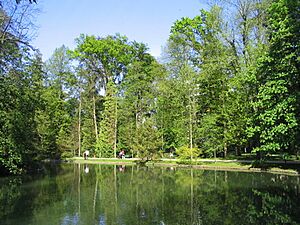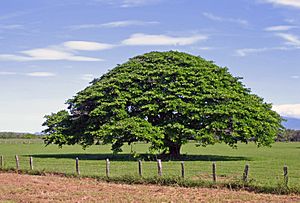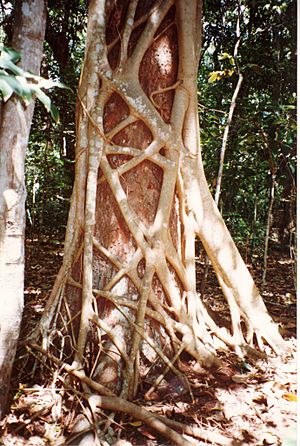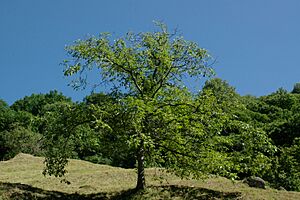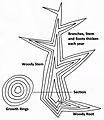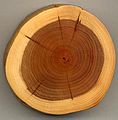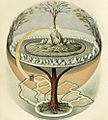Tree facts for kids
A tree is a very tall plant with a strong main stem called a trunk, and branches that are made of wood. Trees can live for a very long time. The oldest tree ever found is about 5,000 years old! In the UK, the oldest tree is around 1,000 years old.
The four main parts of a tree are its roots, trunk, branches, and leaves.
The roots of a tree are usually hidden underground. But some trees, like the mangrove tree, have roots that grow in water. A single tree has many roots. Roots act like straws, pulling nutrients and water from the ground up through the trunk and branches to the leaves. They also help the tree breathe in air. Some roots, like those of the banyan tree, grow above ground to help support the tree.
The trunk is the main body of the tree. It's covered with a tough outer layer called bark, which protects it from harm. Branches grow out from the trunk, spreading wide to help the leaves get as much sunlight as possible.
Most of the time, leaves are green, but they can come in many different colors, shapes, and sizes. Leaves are amazing! They use sunlight, water, and food from the roots to help the tree grow and make new trees.
Trees and shrubs are like nature's air purifiers. They take in water and carbon dioxide from the air. Then, using sunlight, they create sugars for food and release oxygen back into the air. This process is called photosynthesis. It's the opposite of what animals do when they breathe! Trees are also renewable resources, which means if one is cut down, another can grow in its place.
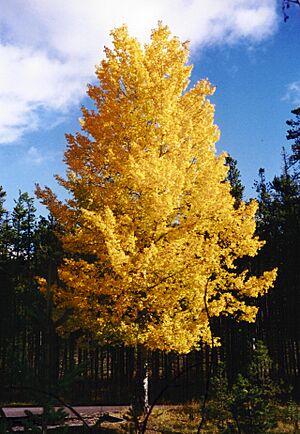
Contents
What Makes Up a Tree?
The main parts of a tree are its roots, trunk, branches, twigs, and leaves. The stems of trees are mostly made of special tissues that provide support and transport water and nutrients. These are called xylem (which makes up wood) and phloem (which is part of the bark).
How Trees Grow: Reading Their Rings
As a tree gets older, it often creates growth rings. These rings are new layers of wood that form around the older wood. In places where the weather changes with the seasons, the wood grown at different times of the year can look light or dark.
In places with four seasons, each pair of light and dark rings usually means one year of growth. If a tree lives where there are two wet and dry seasons each year, it might have two pairs of rings per year. In some dry areas, a new ring might even grow after each rainfall.
In tropical rainforests, where the weather is the same all year, trees grow constantly. Because of this, their growth rings aren't usually visible, and the wood looks the same throughout.
For trees that do have annual rings, counting these rings can tell us how old the tree is. This method is called dendrochronology. It can even help scientists figure out the age of wood from trees that were cut down a long time ago, because the patterns of ring thickness are unique.
Roots: The Tree's Anchor and Feeder
The roots of a tree are almost always underground. They usually spread out in a ball shape under the trunk, but they don't go much deeper than the tree is tall. Some roots can be very short, while others can be many meters long.
Roots are super important because they hold the tree firmly in the ground, keeping it from falling over, especially in strong winds.
Roots also soak up water and nutrients from the soil. Many trees get help from tiny fungus partners in the soil. These fungi help the roots absorb nutrients better, which is why most trees have a favorite type of fungus they work with!
Branches: Reaching for the Sun
Above ground, the trunk lifts the branches high up. This helps the leaves get lots of sunlight, especially when other plants are nearby. The way a tree's branches grow helps all its leaves get enough sun.
Branches start out big and thick where they connect to the trunk, and they get smaller and smaller the farther they grow. Branches often split into even smaller branches, until they end in tiny tips called twigs.
Leaves: The Tree's Food Factories
The leaves of a tree are usually found at the ends of the branches, though some trees have leaves all along their branches. The main jobs of leaves are to make food for the tree (this is called photosynthesis) and to exchange gases with the air.
A leaf is often flat and thin. This shape helps it soak up the most sunlight. Inside the leaves are tiny green parts called chloroplasts. These chloroplasts use sunlight, carbon dioxide from the air, and water from the roots to make glucose (a type of sugar) and oxygen. Most of a tree's weight comes from this amazing process!
Most leaves have tiny openings called stomata. These stomata can open and close to control how much carbon dioxide, oxygen, and water vapor goes in and out of the leaf.
Trees that keep their leaves all year round are called evergreens. Trees that lose their leaves are called deciduous trees. Deciduous trees usually drop their leaves in autumn when it gets cold. Before they fall, the leaves often change into beautiful colors. New leaves will grow back in the spring.
Not All Trees Are the Same!
When we say "tree" in English, we usually mean a plant that lives a long time, has a clear main stem, and grows quite tall and big. But not all trees have all the parts we just talked about. For example, most palm trees don't have branches, and tree ferns don't have bark.
Even with these differences, we still call them trees because of their general shape and size. Trees can look very different from each other! A plant that's similar to a tree but usually smaller, or has many trunks, or branches that start close to the ground, is called a "shrub" or a "bush." There isn't a super strict rule to tell them apart, since these are common English words.
Also, don't get confused by tiny bonsai plants. Even though they are small, they are still "trees" because they are a tiny version of a tree species. A baby spruce plant might not look like a "tree" yet, but all spruce plants grow up to be trees!
Different Kinds of Trees
A tree is a type of plant that can be found in many different groups of plants. Trees come in all sorts of shapes, leaf types, bark styles, and parts.
The tree shape has actually developed many times in different plant groups that aren't closely related. This happened because they all faced similar challenges, like needing to grow tall to reach sunlight. There are about 100,000 different types of trees, which might be about a quarter of all living plant types in the world! Most tree species live in tropical parts of the world, and many of these areas haven't been fully explored by botanists (plant scientists), so we don't fully understand all the different types of trees and where they grow.
The very first trees were tree ferns, horsetails, and lycophytes. They grew in huge forests during the Carboniferous period, a very long time ago. Tree ferns still exist today, but the horsetails and lycophytes we see now don't grow as trees. Later, in the Triassic Period, conifers (like pine trees), ginkgos, cycads, and other gymnosperms appeared. Then, in the Cretaceous period, flowering plants showed up. Today, most tree species are flowering plants (Angiosperms) and conifers.
A small group of trees growing close together is called a grove or copse. A large area covered by many trees is called a forest. Some habitats are even named after the trees that live there, like rainforests and taiga. A landscape with trees spread out across grasslands is called a savanna. A very old forest is known as an old growth forest or ancient woodland (in the UK). A very young tree is called a sapling.
Amazing Tree Records!
Tallest Trees
Scientists in the UK and Malaysia have found the world's tallest tropical tree, which is more than 100 meters (328 feet) high!
A redwood tree in Redwood National Park, California, was measured at 115.85 meters (380 feet) tall, making it the tallest known tree.
The tallest trees in Australia are all types of eucalypts. There are over 700 species of eucalypts! The 'mountain ash' eucalypt, with its slim, straight trunk, can grow to over 300 feet tall.
Stoutest Trees
The widest living single-trunk tree is the African baobab. One baobab in South Africa, called the Glencoe baobab, was measured at 15.9 meters (52 feet) across near the ground! This tree split in 2009, so now the stoutest baobab might be the Sunland Baobab in South Africa, which is 10.64 meters (34.9 feet) wide.
Some trees can grow many trunks that join together. The sacred fig is a great example. It grows new 'trunks' from its branches that reach the ground and get thicker. A single sacred fig tree can have hundreds of these trunks!
Oldest Individual Trees
The age of trees is usually found by counting their growth rings. This works best for trees in places with seasons. Trees in tropical climates often grow all the time and don't have clear rings. Also, some very old trees become hollow inside as their old heartwood decays, making it hard to count rings.
Here are some of the oldest trees whose ages have been confirmed:
- Great Basin bristlecone pine (Methuselah) Pinus longaeva: 4,844 years old
- Alerce: 3,622 years old
- Giant sequoia: 3,266 years old
- Sugi: 3,000 years old
- Huon-pine: 2,500 years old
Other trees thought to be very old include the European Yew (possibly over 2,000 years) and western redcedar. The oldest known European yew is the Llangernyw yew in North Wales, estimated to be between 4,000 and 5,000 years old!
The oldest known flowering plant tree is the Sri Maha Bodhi sacred fig (Ficus religiosa). It was planted in 288 BC in Sri Lanka and is said to be the oldest human-planted tree with a known planting date, making it 2,293 years old.
Oldest Forests
The very first fossilized trees found are from 386 million years ago, in the Devonian period. They were discovered in an old quarry in Cairo, New York. This ancient forest was so huge it stretched beyond Pennsylvania!
This discovery is two or three million years older than the previous oldest forest found at Gilboa, also in New York State.
Fun with Tree Climbing!
Tree climbing is an activity where people move around in the upper parts of trees.
To stay safe, climbers should at least use a rope, helmet, and harness. Other gear can be used depending on how experienced the climber is. Some tree climbers even bring special hammocks called "Treeboats" or Portaledges into the tree tops. They can enjoy a picnic, take a nap, or even spend the night up there!
Tree climbing uses many different skills and tools that first came from rock climbing and caving. These techniques are used to climb trees for many reasons, like taking care of trees (arborists), rescuing animals, for fun, for sports, for scientific research, and for activism.
What Can Harm Trees?
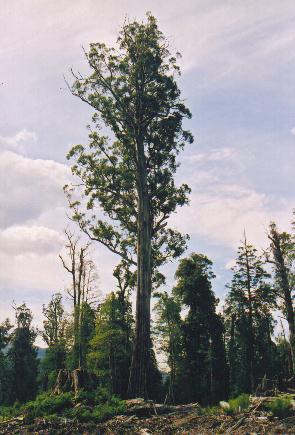
Trees can be damaged in three main ways: by living things (biotic), by non-living things (abiotic), and by deforestation (cutting trees down).
- Biotic damage comes from living sources. This could be insects that bore into the tree, deer that rub their antlers on the bark, or fungi that grow on the tree.
- Abiotic damage comes from non-living sources. Examples include lightning strikes, being hit by vehicles, or problems from construction work. Construction can cause damage in many ways, like changing the ground level (which stops roots from getting air), spills of harmful chemicals like cement, or cutting off branches or roots. People can also damage trees accidentally.
When trees are damaged, they can become dangerous. Arborists (tree experts) often call these "hazard trees." Hazard trees are more likely to fall during storms, or have parts of them break off, because of disease or other damage.
Trees are a bit like people. They can handle some types of harm and still survive. But even a small amount of certain kinds of damage can cause a tree to die. Tree experts know that once a tree is established, its root system should not be disturbed much. Even though this is true, many people don't realize how easily a tree can be killed.
One reason people get confused about tree damage from construction is that trees go dormant in winter. Also, trees might not show signs of damage until 24 months or even longer after the damage happened. So, people who don't know much about trees might not connect the damage they see later with what actually caused it.
Many groups have long understood how important it is to protect trees during construction. Damage to trees can lead to money loss because of repair or replacement costs, and it can also break local rules or laws.
Because of this, there are clear steps for managing trees before, during, and after construction. These steps include:
- Looking at the construction plans.
- Making a list of all the trees.
- Following standard tree management rules.
- Figuring out what damage might happen to trees.
- Creating a plan to protect trees (before, during, and after construction).
- Making a plan to fix any damage.
- Setting up tree protection zones (TPZs) – areas where trees are protected.
- Checking for tree damage after construction.
- Carrying out the plan to fix any damage.
Trees in Culture
Trees have always been important symbols in different cultures. Common ideas include the World tree, like Yggdrasil, and the tree of life. Trees are often used to represent nature or the environment itself. A common mistake is thinking that trees get most of their weight from the ground. Actually, 99% of a tree's weight comes from the air!
Wishing Trees
A Wish Tree is a special tree, often chosen because of its type, location, or how it looks. People use it to make wishes and leave offerings. These trees are seen as having a special religious or spiritual meaning. Traditionally, people make offerings to these trees, hoping that a nature spirit, saint, or goddess will grant their wish.
Tree Worship
Tree worship means that many societies throughout history have worshipped or created myths about trees. Trees have played a very important role in many of the world's mythologies and religions. They have been given deep and sacred meanings for ages. People see how trees grow and die, how flexible their branches are, and how their leaves change and come back every year. Because of this, trees are powerful symbols of growth, decay, and resurrection. The oldest symbol across many cultures for how the universe is built is the 'world tree'.
World Tree
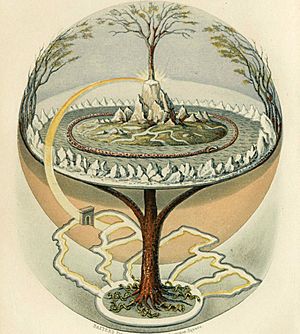
A tree, with its branches reaching up to the sky and roots deep into the earth, can be seen as living in three worlds. It connects heaven, the earth, and the underworld, joining what's above with what's below. It's also a symbol of both feminine (giving life) and masculine (strong) qualities – another union.
Because of this, many myths around the world have the idea of a World tree. This is a huge tree that acts as an Axis mundi (a central point of the world), holding up the cosmos and linking the heavens, earth, and underworld. In European mythology, the most famous example is the tree Yggdrasil from Norse mythology.
The world tree is also a big part of Mesoamerican myths. There, it represents the four main cardinal directions (north, south, east, and west). The idea of the world tree is also closely connected to the idea of the Tree of life.
In Literature
In books and stories, a famous mythology about trees was created by J.R.R. Tolkien. His Two Trees of Valinor are very important in his 1964 book Tree and Leaf. William Butler Yeats also writes about a "holy tree" in his poem The Two Trees (1893).
List of Trees
There are many types of trees. Here is a list of some of them:
- Apple tree
- Coconut palm
- Cottonwood
- Eucalyptus
- Fir
- Horse chestnut
- Mangrove
- Maple
- Oak
- Palm
- Pine
- Redwood
- Rubber tree
- Willow
- Yew
- Birch
Related Pages
- Wattezia is the earliest tree found in old rock records.
Images for kids
-
Beech leaves
-
Growth rings. The dark lines between the center and the bark are medullary rays, which allow nutrients to flow across the tree trunk
-
Common ash (Fraxinus excelsior), a deciduous broad-leaved (angiosperm) tree
-
Diagram of secondary growth in a eudicot or coniferous tree showing idealised vertical and horizontal sections. A new layer of wood is added in each growing season, thickening the stem, existing branches and roots.
-
Tall herbaceous monocotyledonous plants such as banana lack secondary growth, but are trees under the broadest definition.
-
Conifers in the Swabian alps
-
Dormant Magnolia bud
-
Lepidodendron, an extinct lycophyte tree
-
Sugar maple (Acer saccharum) tapped to collect sap for maple syrup
-
Trees in art: Weeping Willow, Claude Monet, 1918
-
Recently stripped cork oak (Quercus suber)
-
Alleé of London plane trees (Platanus × acerifolia) in garden
-
Latex collecting from a rubber tree (Hevea brasiliensis)
-
Yggdrasil, the World Ash of Norse mythology
-
The General Sherman Tree, thought to be the world's largest by volume
See also
 In Spanish: Árbol para niños
In Spanish: Árbol para niños


